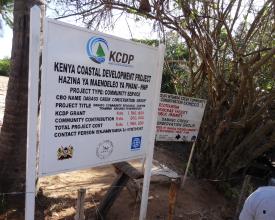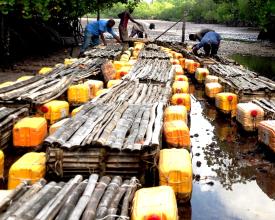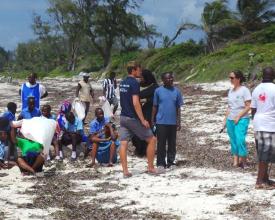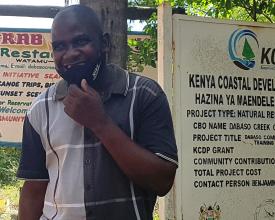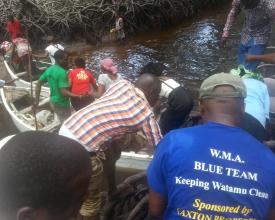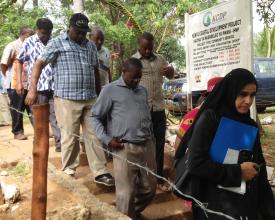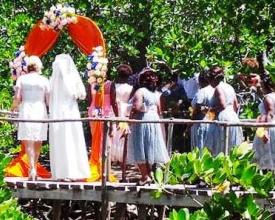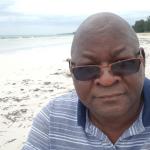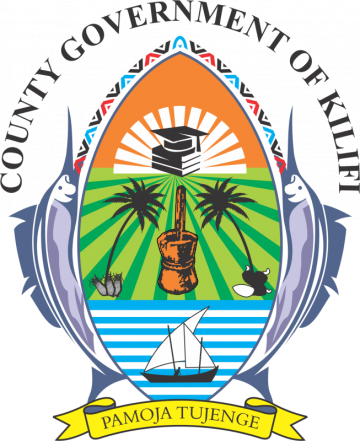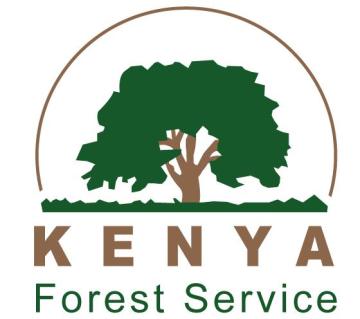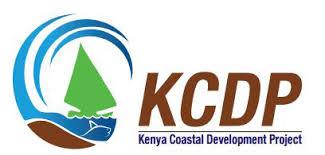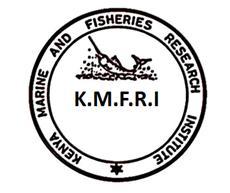
Ejemplo de relación simbiótica fructífera entre el ser humano y el medio ambiente: Interacción beneficiosa entre los manglares, el arroyo Dabaso y la comunidad local.
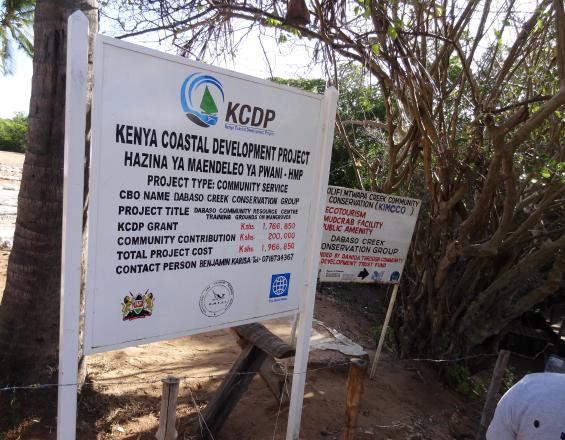
Las orillas del arroyo Mida, situado a unos 100 kilómetros al norte de Mombasa (Kenia) y adyacente al bosque Arabuko Sokoke, están formadas por ecosistemas marinos y costeros que comprenden arrecifes de coral, praderas marinas y manglares, cruciales para la subsistencia de la comunidad costera local. Los arrecifes de coral proporcionan alimentos e ingresos a las comunidades y otros bienes y servicios de importancia estratégica para la economía, como el turismo, la pesca y la protección costera.
En 2014-2016, el Dabaso Creek Conservation Group (DCCG) recibió una subvención del programa de desarrollo comunitario Hazina ya Maendeleo ya Pwani (HMP) del Banco Mundial. Los fondos se destinaron a la construcción de un centro de recursos, la ampliación de la zona de cocina/restaurante y la extensión del paseo marítimo. El DCCG es una organización de base comunitaria situada en la zona de Watamu, en el pueblo de Dabaso.
Contexto
Défis à relever
- Los manglares han sido utilizados por la comunidad de los alrededores de Dabaso desde tiempos inmemoriales como material de construcción, leña, medicinas y muchos otros fines. Convencer a la comunidad de que impidiera la tala de manglares para reducir la erosión del litoral y otros efectos perjudiciales para el medio ambiente fue todo un reto.
- El vertido de envases de plástico, restos de comida del restaurante y materiales de desecho tras las labores de mantenimiento suponía una gran amenaza para el medio ambiente.
- La ubicación de los aseos en medio del bosque de manglares era un reto. La DCCG solucionó este problema construyendo los aseos en tierra firme, lejos de los manglares.
- Escasez ocasional de semillas (propágulos) para plantar nuevos manglares.
- La comida se acababa debido al excesivo número de huéspedes que llegaban de hoteles cercanos sin acuerdo previo.
Ubicación
Procesar
Resumen del proceso
Todos los componentes interactúan en paralelo.
El DCCG se ha beneficiado enormemente de la colaboración con organismos gubernamentales nacionales, así como con ONG locales e internacionales. El Instituto de Investigación Marina y Pesquera de Kenia (KMFRI) ofrece asesoramiento técnico sobre la fabricación de jaulas adecuadas para cangrejos, formación sobre métodos apropiados de replantación de manglares, colaboración en la búsqueda de subvenciones para el desarrollo de socios regionales y mundiales, suministro de guías científicas de campo para su traducción al idioma local, etc.
El Servicio de Vida Silvestre de Kenia (KWS) protege los manglares de la destrucción indiscriminada por parte de promotores y trabajadores de la construcción, usuarios de embarcaciones, pescadores, etc. Protege los manglares del uso indebido por parte de leñadores, visitantes e incluso la población local.
Estudiantes de escuelas primarias, institutos y universidades de toda Kenia visitan Dabaso todos los meses en viajes de estudios y excursiones. Aprenden sobre los manglares, sus valores culturales y su uso gracias a las charlas de los miembros de la DCCG y la población local. Bajo la dirección de la DCCG, la comunidad local participa en actividades de protección del medio ambiente, como la limpieza de playas y la plantación no sólo de manglares, sino también de árboles terrestres autóctonos que crecen a lo largo de la zona costera.
Bloques de construcción
Programas de formación para la conservación del medio ambiente
La formación de los miembros del DGGC y de la comunidad local en materia de conservación del medio ambiente tiene por objeto capacitar a la población para proteger y conservar el medio ambiente en aras de la prosperidad y el uso sostenible. La formación corre a cargo del Instituto de Investigación Marina y Pesquera de Kenia (KMFRI), el Fondo Mundial para la Naturaleza (WWF), el Servicio Forestal de Kenia (KFS) y varias ONG. La formación ha dado lugar a :
- La restauración de varias especies de manglares mediante programas de reforestación.
- El cese de los métodos ilegales de pesca, incluido el uso de veneno y redes de malla pequeña.
- Reducción de la presión pesquera de Mida Creek
- Mantener la Reserva Mundial de la Biosfera Malindi-Watamu como parte de las zonas marinas protegidas de la costa de Kenia.
Factores facilitadores
La mayoría de los miembros de la comunidad han aceptado los programas de formación. La comunidad colabora ahora con los formadores para crear conciencia medioambiental, un elemento muy importante para lograr el objetivo de este proyecto.
Lección aprendida
Las visitas de estudiantes de colegios, universidades y escuelas superiores, los paseos en barco y las excursiones de observación de aves han sido formas estupendas de ayudar a concienciar sobre los problemas medioambientales.
Utilizar la lengua local, el kiswahili, para explicar a la comunidad ha dado resultados más rápidos.
Participación de la comunidad local, planes futuros de sostenibilidad
Para la sostenibilidad de DCCG y el beneficio de la comunidad a largo plazo, el grupo se ha centrado en las siguientes acciones:
- Construir alojamientos ecológicos en sus terrenos adyacentes al arroyo.
- Introducir medios de transporte respetuosos con el medio ambiente para facilitar el acceso al restaurante y al paseo marítimo.
- Crear un centro de aprendizaje informático para capacitar a los jóvenes.
- Explorar nuevas ideas para aumentar las oportunidades de empleo de la comunidad;
- Ampliar la limpieza de la playa a la limpieza de las calles de Watamu.
- Contribuir al fondo de becas para la educación de los alumnos de las escuelas locales.
Factores facilitadores
- Asociación con el Gobierno nacional, KMFRI, KWS, KFS en la gestión de los manglares.
- La colaboración con ONG locales e internacionales como WWF, KWETU y proyectos nacionales como KCDP, KEMFSED han creado fuertes vínculos para la sostenibilidad.
Lección aprendida
La creación de asociaciones permite alcanzar los objetivos de una forma más sólida y eficaz y crear vínculos sólidos para la sostenibilidad.
Ampliación del restaurante Crab Shark
El restaurante Crab Shack se ha convertido en el icono de DCCG. Es famoso por su emblemática pasta samosa, deliciosamente elaborada con cangrejos recogidos en trampas fabricadas localmente.
La ampliación del restaurante gracias a los fondos obtenidos del KCDP en el marco del HMP ha permitido:
- Atraer a más visitantes para celebraciones y eventos.
- Oportunidades de empleo para las comunidades locales, especialmente para los jóvenes.
- El restaurante Crab Shark atrae a turistas de los hoteles cercanos que vienen a disfrutar del ambiente único de los manglares, donde los cangrejos se crían en jaulas en los arroyos.
Factores facilitadores
- Apoyo garantizado del Gobierno del Condado de Kilifi.
- Más visitantes locales y extranjeros.
- Oportunidades de empleo para las comunidades locales, especialmente los jóvenes.
- Aumento de los paseos en canoa para disfrutar de la puesta de sol y la observación de aves.
Lección aprendida
El hecho de que la DCCG haya llegado a acuerdos con la dirección de hoteles turísticos situados en la zona de Watamu y en la ciudad de Malindi ha permitido situar el restaurante Cangrejo-Tiburón en el itinerario de visita de los turistas, dando así mayor notoriedad al manglar a través de su restaurante. El trabajo conjunto con otras empresas de la zona genera alianzas eficaces para el éxito del proyecto.
Impactos
- Acuerdos con la dirección de los hoteles turísticos situados en la zona de Watamu y la ciudad de Malindi para incluir el restaurante Crab-Shark en el itinerario de visita de los turistas.
- Contribución al desarrollo de escuelas y otros servicios comunitarios en los alrededores de Dabaso y Watamu, como dispensarios. Se asignan días especiales a las escuelas para que visiten el DCCG y aprendan más sobre la importancia de los manglares, la cría de cangrejos en jaulas y la conservación y protección del entorno costero.
- Los jóvenes adquieren experiencia práctica y conocimientos sobre la protección y conservación del entorno costero. Se invita a los miembros del DCCG a visitar zonas similares en Malindi, Kilifi, Mombasa y Kwale para enseñar a otros jóvenes a empoderarse y ganarse la vida con un planteamiento similar.
Beneficiarios
- Miembros individuales de la comunidad.
- Miembros de grupos culturales, mediante la interpretación de danzas tradicionales para entretener a los invitados.
- Las escuelas del barrio tienen acceso regular al centro de formación del DCCG.
- Los propietarios de canoas obtienen ingresos transportando turistas a los manglares.
Objetivos de Desarrollo Sostenible
Historia
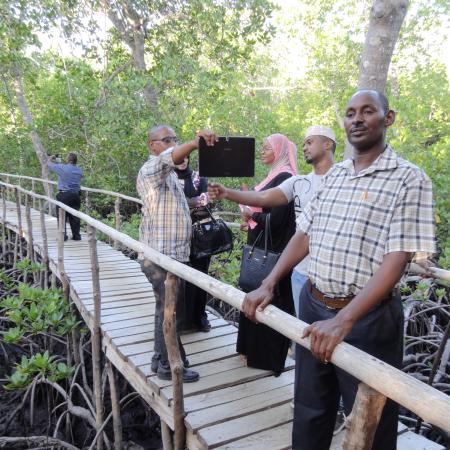
Proteger la vida marina de Dabaso y Mida Creek viviendo entre los manglares
Parte del éxito del DCCG comenzó a finales de los años 90, cuando investigadores de la Universidad de Florencia (Italia) dirigidos por los profesores Marco Vannini y Giuseppe Messana visitaron la costa de Kenia. Establecieron una investigación en colaboración con el Instituto de Investigación Marina y Pesquera de Kenia (KMFRI) bajo la dirección del Dr. Renison Ruwa y tres jóvenes investigadores en ciernes, a saber, James Mwaluma, Diana Anyona y Melckzedeck Osore. El equipo identificó Dabaso como una zona adecuada para investigar los cangrejos y las infestaciones de isópodos en las raíces de los manglares. Los investigadores solían acampar en Watamu y trabajar día y noche estudiando la migración de los cangrejos y su interacción con los manglares. Los jóvenes locales, algunos de ellos jóvenes empleados de los hoteles turísticos de Watamu, solían ayudar guiando a los investigadores por el bosque de manglares y las zonas intermareales mientras identificaban diversas especies de cangrejos y observaban su comportamiento. Los resultados aportaron muchos conocimientos, que más tarde se publicaron en diversas revistas científicas y también se presentaron como tesis de máster y doctorado de varios investigadores keniatas e italianos.
Benjamin Karisa, uno de los líderes del DCCG, recuerda: "Cuando era pequeño, a principios de los 90, veía con asombro cómo investigadores de Bélgica, Italia y el KMFRI dedicaban mucho tiempo a observar el movimiento de los cangrejos en la arena y los manglares durante muchas semanas. Su intento de hablarnos a los niños en un kiswahili entrecortado solía divertirme mucho. No me daba cuenta de que inconscientemente estaba aprendiendo y comprendiendo cómo interactúan los cangrejos y los manglares, y que algún día me convertiría en un experto".
La comunidad local reconoció la importancia de Dabaso y del arroyo Mida en general como posible lugar de escala para los investigadores y estableció un pequeño pontón en la zona intermareal donde acamparían y ayudarían a los científicos. A partir de entonces, el paseo marítimo se unió al primer restaurante construido en medio de los manglares.Las instalaciones construidas por la DCCG se han hecho muy populares para albergar actos sociales como bodas, dar conferencias a estudiantes, lugar de reunión preferido por instituciones gubernamentales y ONG, punto de entrada de paseos en barco para turistas y un escenario espectacular para la observación de aves, así como para disfrutar de una bebida o una comida de cangrejo-samosa y otras delicias costeras mientras se observa la puesta de sol en el océano Índico.

